| Western blot (WB): | 1:500-2000 |
| Immunohistochemistry (IHC): | 1:50-400 |
| Flow Cytometry (Fixed): | 1:50-200 |
| (Boiling the paraffin sections in 10mM citrate buffer,pH6.0,or PH8.0 EDTA repair liquid for 20 mins is required for the staining of formalin/paraffin sections.) Optimal working dilutions must be determined by end user. | |

Western blot analysis of CCR1 using anti-CCR1 antibody (PB9991). The sample well of each lane was loaded with 30 ug of sample under reducing conditions.
Lane 1: rat brain tissue lysates,
Lane 2: mouse brain tissue lysates.
After electrophoresis, proteins were transferred to a membrane. Then the membrane was incubated with rabbit anti-CCR1 antigen affinity purified polyclonal antibody (PB9991) at a dilution of 1:1000 and probed with a goat anti-rabbit IgG-HRP secondary antibody (Catalog # BA1054). The signal is developed using ECL Plus Western Blotting Substrate (Catalog # AR1197). A specific band was detected for CCR1 at approximately 41 kDa. The expected band size for CCR1 is at 41 kDa.
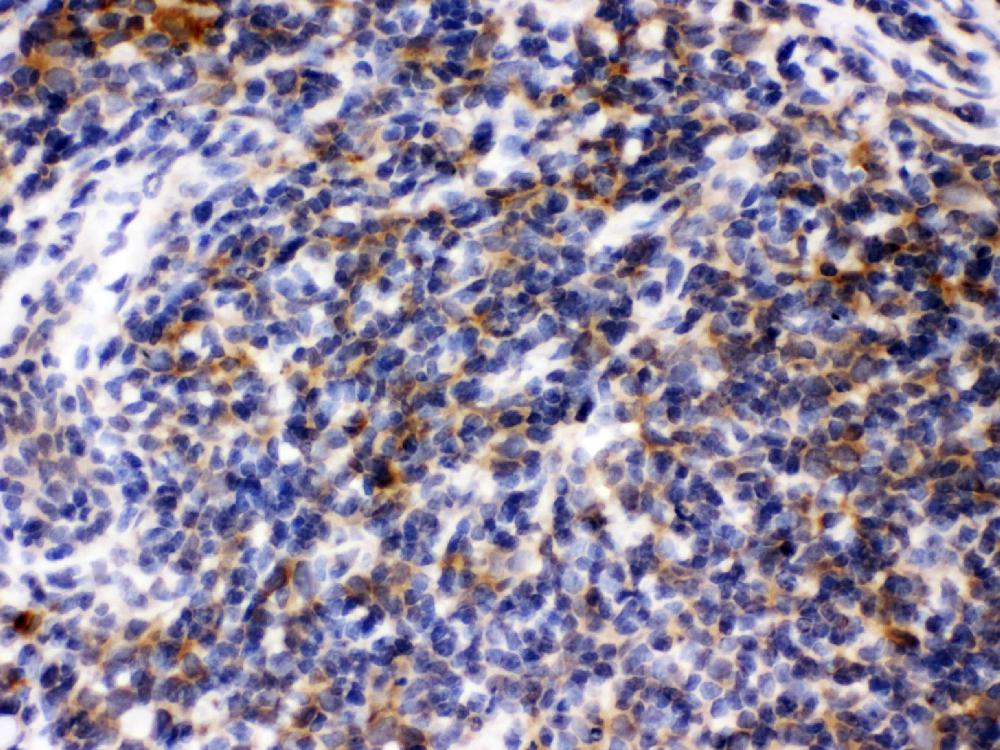
IHC analysis of CCR1 using anti-CCR1 antibody (PB9991).
CCR1 was detected in a paraffin-embedded section of mouse lymphaden tissue. Biotinylated goat anti-rabbit IgG was used as secondary antibody. The tissue section was incubated with rabbit anti-CCR1 Antibody (PB9991) at a dilution of 1:200 and developed using Strepavidin-Biotin-Complex (SABC) (Catalog # SA1022) with DAB (Catalog # AR1027) as the chromogen.
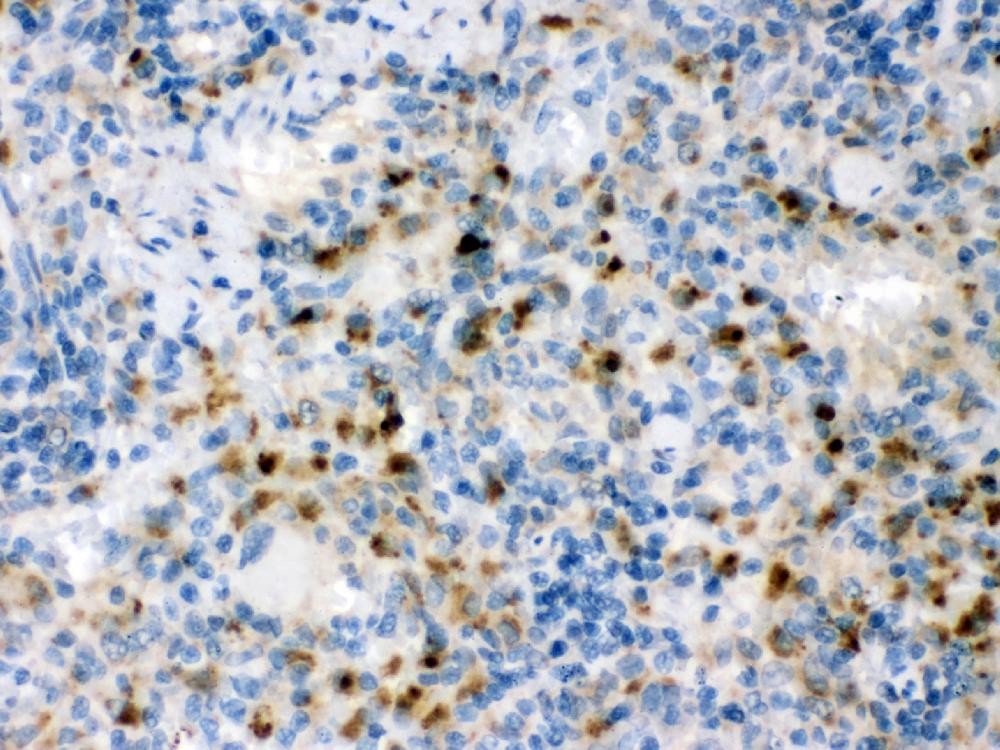
IHC analysis of CCR1 using anti-CCR1 antibody (PB9991).
CCR1 was detected in a paraffin-embedded section of rat spleen tissue. Biotinylated goat anti-rabbit IgG was used as secondary antibody. The tissue section was incubated with rabbit anti-CCR1 Antibody (PB9991) at a dilution of 1:200 and developed using Strepavidin-Biotin-Complex (SABC) (Catalog # SA1022) with DAB (Catalog # AR1027) as the chromogen.
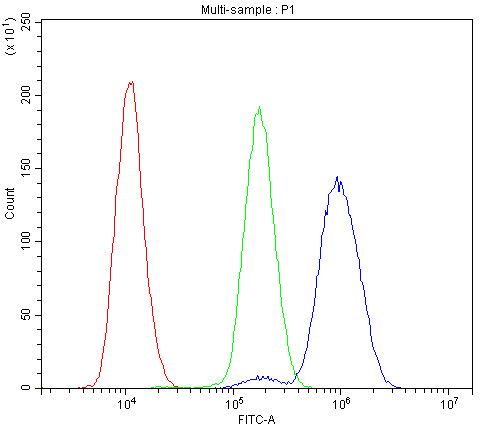
Flow Cytometry analysis of RAW264.7 cells using anti-CCR1 antibody (PB9991).Overlay histogram showing RAW264.7 cells stained with PB9991 (Blue line).The cells were blocked with 10% normal goat serum. And then incubated with rabbit anti-CCR1 Antibody (PB9991, 1:100) for 30 min at 20°C. DyLight®488 conjugated goat anti-rabbit IgG (BA1127, 1:100) was used as secondary antibody for 30 minutes at 20°C. Isotype control antibody (Green line) was rabbit IgG (1:100) used under the same conditions. Unlabelled sample (Red line) was also used as a control.
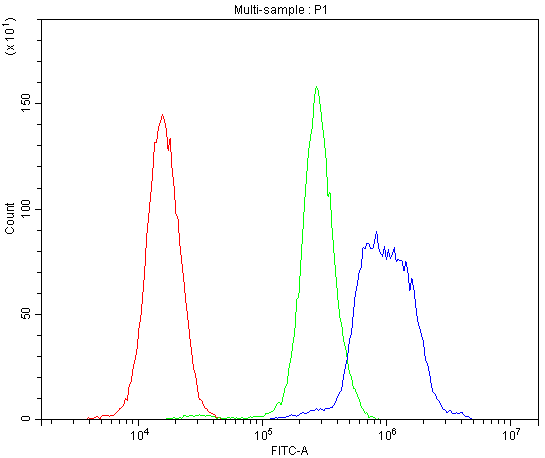
Flow Cytometry analysis of SP2-0 cells using anti-CCR1 antibody (PB9991).Overlay histogram showing SP2-0 cells stained with PB9991 (Blue line).The cells were blocked with 10% normal goat serum. And then incubated with rabbit anti-CCR1 Antibody (PB9991, 1:100) for 30 min at 20°C. DyLight®488 conjugated goat anti-rabbit IgG (BA1127, 1:100) was used as secondary antibody for 30 minutes at 20°C. Isotype control antibody (Green line) was rabbit IgG (1:100) used under the same conditions. Unlabelled sample (Red line) was also used as a control.
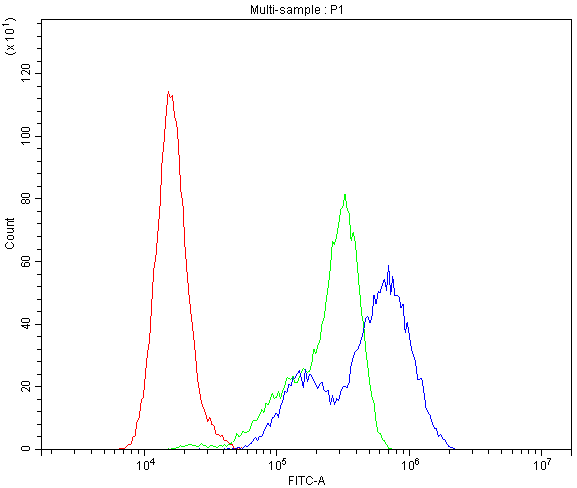
Flow Cytometry analysis of YAC-1 cells using anti-CCR1 antibody (PB9991).Overlay histogram showing YAC-1 cells stained with PB9991 (Blue line).The cells were blocked with 10% normal goat serum. And then incubated with rabbit anti-CCR1 Antibody (PB9991, 1:100) for 30 min at 20°C. DyLight®488 conjugated goat anti-rabbit IgG (BA1127, 1:100) was used as secondary antibody for 30 minutes at 20°C. Isotype control antibody (Green line) was rabbit IgG (1:100) used under the same conditions. Unlabelled sample (Red line) was also used as a control.

Western blot analysis of CCR1 using anti-CCR1 antibody (PB9991). The sample well of each lane was loaded with 30 ug of sample under reducing conditions.
Lane 1: rat brain tissue lysates,
Lane 2: mouse brain tissue lysates.
After electrophoresis, proteins were transferred to a membrane. Then the membrane was incubated with rabbit anti-CCR1 antigen affinity purified polyclonal antibody (PB9991) at a dilution of 1:1000 and probed with a goat anti-rabbit IgG-HRP secondary antibody (Catalog # BA1054). The signal is developed using ECL Plus Western Blotting Substrate (Catalog # AR1197). A specific band was detected for CCR1 at approximately 41 kDa. The expected band size for CCR1 is at 41 kDa.

IHC analysis of CCR1 using anti-CCR1 antibody (PB9991).
CCR1 was detected in a paraffin-embedded section of mouse lymphaden tissue. Biotinylated goat anti-rabbit IgG was used as secondary antibody. The tissue section was incubated with rabbit anti-CCR1 Antibody (PB9991) at a dilution of 1:200 and developed using Strepavidin-Biotin-Complex (SABC) (Catalog # SA1022) with DAB (Catalog # AR1027) as the chromogen.

IHC analysis of CCR1 using anti-CCR1 antibody (PB9991).
CCR1 was detected in a paraffin-embedded section of rat spleen tissue. Biotinylated goat anti-rabbit IgG was used as secondary antibody. The tissue section was incubated with rabbit anti-CCR1 Antibody (PB9991) at a dilution of 1:200 and developed using Strepavidin-Biotin-Complex (SABC) (Catalog # SA1022) with DAB (Catalog # AR1027) as the chromogen.

Flow Cytometry analysis of RAW264.7 cells using anti-CCR1 antibody (PB9991).Overlay histogram showing RAW264.7 cells stained with PB9991 (Blue line).The cells were blocked with 10% normal goat serum. And then incubated with rabbit anti-CCR1 Antibody (PB9991, 1:100) for 30 min at 20°C. DyLight®488 conjugated goat anti-rabbit IgG (BA1127, 1:100) was used as secondary antibody for 30 minutes at 20°C. Isotype control antibody (Green line) was rabbit IgG (1:100) used under the same conditions. Unlabelled sample (Red line) was also used as a control.

Flow Cytometry analysis of SP2-0 cells using anti-CCR1 antibody (PB9991).Overlay histogram showing SP2-0 cells stained with PB9991 (Blue line).The cells were blocked with 10% normal goat serum. And then incubated with rabbit anti-CCR1 Antibody (PB9991, 1:100) for 30 min at 20°C. DyLight®488 conjugated goat anti-rabbit IgG (BA1127, 1:100) was used as secondary antibody for 30 minutes at 20°C. Isotype control antibody (Green line) was rabbit IgG (1:100) used under the same conditions. Unlabelled sample (Red line) was also used as a control.

Flow Cytometry analysis of YAC-1 cells using anti-CCR1 antibody (PB9991).Overlay histogram showing YAC-1 cells stained with PB9991 (Blue line).The cells were blocked with 10% normal goat serum. And then incubated with rabbit anti-CCR1 Antibody (PB9991, 1:100) for 30 min at 20°C. DyLight®488 conjugated goat anti-rabbit IgG (BA1127, 1:100) was used as secondary antibody for 30 minutes at 20°C. Isotype control antibody (Green line) was rabbit IgG (1:100) used under the same conditions. Unlabelled sample (Red line) was also used as a control.





